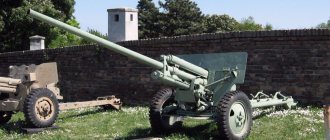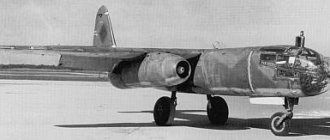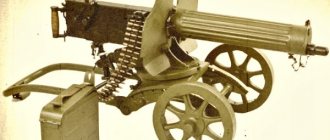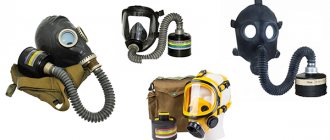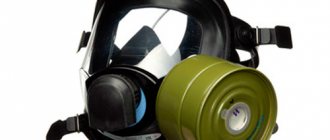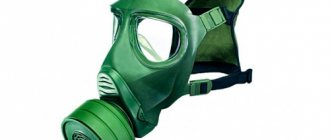Gas mask and respirator: distinctive features
Personal chemical protection equipment is divided into two main categories; they can be in the form of gas masks and respirators. Often people with an unprofessional eye can confuse them with each other, especially since some modifications of products are indeed similar. In order not to make mistakes when choosing devices, experts recommend studying their types, components, purpose, how a GP filter gas mask or respirator functions, what is their difference, and also what dangers a gas mask warns against.
The main difference between these two products is that the respirator does not cover the entire face, or rather, only the area of the nose and mouth, everything else remains open. Whereas a gas mask covers the entire head, eyes and protects the respiratory organs from the penetration of harmful elements.
https://youtube.com/watch?v=ltvUloDZ-qI
This feature of using respirators in conditions where there are substances nearby that can penetrate the body through the skin or eyes is unsafe. You should know that you shouldn’t even be around hazardous substances, interaction with which is undesirable, let alone working. These substances may be acid gases, inorganic corrosive gases, and many other hazardous materials. It is also advisable to remember about radioactive dust, from which a gas mask will save you, but a respirator will not.
Protection Equipment
While chemists came up with increasingly complex formulas to damage the human body, others tried to come up with protection. But these funds were pitiful.
It all started with ordinary bandages soaked in special solutions. Such masks did not stick well to the face; you had to support them with your hand; in addition, they dried out faster than the gas dissolved. Soon the bandages were replaced with flannel bags with glasses for the eyes and French Tambutu snout masks.
We also used flannel bags with glasses for the eyes.
The British, for example, used a “Pi-8 helmet” with a mouthpiece for exhalation. But the dampened cloth could not protect against all types of gas - it was necessary to find a universal remedy.
Design and principle of operation
The design of the gas mask, despite all the external differences, has generally been more or less the same for several decades. The isolating face mask plays a very important role in the normal operation of the device. It is this that prevents the entry of hazardous substances and radiation onto the main surface of the face. The mask consists of rubber, since this material is relatively chemically neutral and reliable in a wide variety of conditions. Rubber is painted black or gray, exceptions are rare. The structure of the mask includes the following main parts:
- common building;
- assembly with glass eyepieces;
- a special device - a fairing;
- box with gas valve.
The difference between specific versions may also lie in their size. Sometimes the design of a gas mask involves moving all the key parts to the frontal plane (which simplifies the manipulation of optical instruments). Some models have larger glasses or are even equipped with one large eyepiece instead of two traditional glasses. The role of the fairings is to blow the glass from the inside. As a result, the visibility of surrounding objects is significantly improved; The glass is selected so that there is no risk of fogging. The filtration boxes of gas masks contain a sorbent that absorbs hazardous substances and/or converts them into a safe form. The composition of this sorbent determines which specific toxins and in what concentration it will be able to stop.
First chemical attacks
On April 22, 1915, a yellow-green cloud covered the battlefield in Belgium. The scent of pineapple and pepper was in the air. This is how the Kaiser’s army used chemical weapons for the first time in history. Chlorine caused a suffocating cough, chest pain, water collecting in the lungs, and after a few days the person died.
Phosgene had a similar effect, but it was recognized by the smell of rotten fish. And the third type of gas is also the most insidious - mustard. It affected all wet parts of the body - eyes, sweaty skin, legs soaked in the trenches.
The soldiers began to vomit, lose their sight, and their bodies became covered in blisters. In the first 3 weeks alone, this gas killed and seriously injured 14 thousand soldiers. Artillery forever changed its face - now they were afraid not only of the shell, but also of the substances it released.
Zelinsky gas mask: structure
There were three prototypes - Petrograd, Moscow and state-owned.
The first gas mask of the Petrograd model entered service in 1915. The helmet was put on a rectangular gas mask box with two bottoms, the size of the box was 200:80:50 millimeters. The lower bottom with the neck was closed with a cork stopper, and the same neck, but higher, was soldered into the upper one. Between them there was a metal mesh with a layer of gauze on both sides. Between the gauze pads there was 3-6 mm granular activated carbon. The filter volume was 700 cubic meters. centimeters, length - 174 mm. The box was protected by a tin cap. The mask was orange, the box was secured with tape.
The Moscow model entered service in 1916 and was smaller in size with an oval-shaped box. The volume of the carbon filter became 1000 cubic centimeters.
However, testing showed the need for improvement. And a third version of Zelinsky’s gas mask appeared - the type of the State Gas Mask Plant. It was somewhat shorter than the previous one, with an elliptical box.
Study of the adsorption properties of activated carbon in practice
Experience No. 1
Purpose of the experiment: Study of the adsorption properties of activated carbon in practice.
Methodology for conducting the experiment:
Prepare a diluted solution of dye (muchsin and litmus). Pour 2-3 ml of solutions into test tubes, add activated carbon to each test tube, cap and shake vigorously several times.
Observations: discoloration of fuchsin and litmus solutions in test tubes.
Experience No. 2
Purpose of the experiment: Study of the adsorption properties of activated carbon in practice.
Methodology for conducting the experiment:
We obtained nitric oxide (IV) - a brown gas. Trying to prevent gas losses, we quickly placed 2-3 tablets of activated carbon into a test tube with gas, capped it and shook it several times.
Observations: disappearance of the brown color of the gas in the test tube.
Conclusions: as a result of the experiments carried out in practice, we were convinced that activated carbon exhibits adsorption properties.
Petroleum cracking, activated carbon and gas mask
The scientific activity of Nikolai Zelinsky was wide and varied, but one of its main directions was the search for oxide catalysts for oil cracking. In particular, Zelinsky proposed a way to improve the catalytic densification reaction of acetylene into benzene using activated carbon as a catalyst.
Around this time, in 1915, Zelinsky carried out work on the adsorption and creation of a coal gas mask, which was adopted by the Russian and Allied armies during the First World War and saved many lives.
The characteristic horn on the gas mask attracts attention: there is an army myth that says that it is necessary “to prevent the cap from slipping down.” In fact, its purpose is to insert your finger inside the mask to wipe the glass from the inside. It must be admitted that Zelinsky was not the first to discover the ability of charcoal to absorb chlorine, hydrogen sulfide and ammonia vapors from the air
This was done in 1854 by the Scottish chemist John Stenhouse, who developed a respirator, which is a mask that covers a person’s face from the bridge of the nose to the chin. Charcoal powder was placed in the space between two hemispheres formed by copper wire mesh. Stenhouse carbon filters were only one of the alternatives and were not widely used before Zelinsky’s work
It must be admitted that Zelinsky was not the first to discover the ability of charcoal to absorb chlorine, hydrogen sulfide and ammonia vapors from the air. This was done in 1854 by the Scottish chemist John Stenhouse, who developed a respirator, which is a mask that covers a person’s face from the bridge of the nose to the chin. Charcoal powder was placed in the space between two hemispheres formed by copper wire mesh. Stenhouse carbon filters were only one of the alternatives and were not widely used before Zelinsky’s work.
The first who proposed using birch charcoal taken from the fireplace, activated by calcination, to purify chemical solutions, drinking water, to remove fusel oils from vodka and to protect meat from rotting, was Toviy Egorovich, aka Johann Tobias Lowitz. Lowitz, who was born in Göttingen and came to Russia as a child, enjoyed the special favor of Mikhail Lomonosov, headed the Main Pharmacy in St. Petersburg, and at the end of his life was elected academician of the Russian Academy of Sciences.
Gas masks of the second half of the 19th century were improved from model to model, until in 1879 the American Hutson Hard proposed a gas mask in the form of a mask made of vulcanized rubber.
Hard's filter cup mask (1879)
However, neither Hard nor the German chemist and inventor Bernhard Lab used activated carbon as a filter or used it only as an auxiliary agent. The American Samuel Danilevich recalled the sorbing properties of charcoal in 1909. The filter box of his gas mask, like that of the British James Scott, was filled with charcoal. True, in addition to coal, the inventors also used other filters.
Zelinsky’s priority is that Nikolai Dmitrievich used not just charcoal, but activated carbon (its production was first established in Germany), that is, prepared in a special way, with increased adsorption capacity: the total pore surface of one cubic centimeter of activated carbon can have an area of up to 1500 sq. meters.
Activated carbon granules and their appearance at 300x magnification.
In addition, Zelinsky attracted industrial engineer Edmond Kummant to the work.
In combat conditions, even the penetration of a small amount of a toxic substance, due to the loose fit of the gas mask to the skin of the face, became fatal. Edmond Kummant solved the problem of “mask fit”, and his name deservedly went down in history as the name of a full-fledged co-author of the gas mask. The originality of Cummant's mask was also recognized by the fact that in 1918 the British Patent Office issued him patent No. 19587 for a gas mask.
Scientists' mistakes
The path to creating protective equipment was not straight and smooth. Chemists' mistakes turned out to be fatal. As already noted, one of the most pressing problems was the search for neutralizing reagents. Scientists needed to find a substance so that it would be:
- effective against poisonous gases;
- harmless to humans;
- inexpensive to produce.
A variety of substances were assigned to serve as a universal remedy, and since the enemy did not give time for in-depth research, practicing gas attacks at any opportunity, insufficiently studied substances were often proposed. One of the main arguments in favor of one or another reagent was the economic side of the issue. Often a substance was recognized as suitable only because it was easier for them to supply the army.
After the first gas attacks, military personnel begin to be provided with gauze bandages. They are produced by various organizations, including public organizations. There were no instructions for their manufacture; the troops received a variety of masks, often completely useless, since they did not provide airtightness during breathing. The filtering properties of these products were also questionable. One of the most serious mistakes was the use of sodium hyposulfite as an active reagent. When the substance reacted with chlorine, it released sulfur dioxide, causing not just suffocation, but a burn to the respiratory tract. In addition, the reagent turned out to be completely useless against organic toxic substances used by the enemy.
The discovery of the neutralizing effect of methenamine saved the situation somewhat. However, even in this case, the problem of the mask not fitting tightly to the face remained acute. The fighter had to press the mask tightly with his hands, which made active combat impossible.
The invention of Zelinsky-Kumant helped solve a whole tangle of seemingly insoluble problems.
How to use?
For a specific gas mask, reliability is determined by the power of gas protection and the level of tightness. If the protection is weak or the seal is broken, dangerous agents can penetrate under the face mask. Therefore, it is necessary to carefully protect the geometry of the protective device, and if it is violated, dispose of it immediately. Despite the increased reliability of the exhalation valves, they must be carefully cleaned after each use. The shelf life for a specific model is set by the manufacturer, but in most cases it is not advisable to use them after 5 years.
The wearing of gas masks should be kept to a minimum whenever possible. Even the best versions of them are not able to provide completely physiological breathing. Before each use, you must inspect the mask to ensure that it is free of flaws and mechanical damage (punctures, cuts, tears, dents). The norm for daily and session use should not be exceeded, except in the most extreme cases and particularly difficult situations. Wearing RPE is permissible only in specially designed bags - bags, backpacks, household bags and everything else cannot be used.
Warehouses for gas masks:
- must exclude direct sunlight;
- designed for a minimum level of dust (best with self-leveling, concrete or asphalt floors);
- equipped with reliable ventilation;
- have basic and emergency lighting;
- must prevent liquid water from entering even into the room itself, not to mention RPE;
- cannot be used simultaneously for storing toxic, caustic, radioactive, flammable substances.
To learn how to use a gas mask correctly, watch the following video.
Interesting Facts
- One of the first prototypes of gas masks in Russia were glass caps with flexible hoses, which were used when gilding the domes of St. Isaac's Cathedral in St. Petersburg in 1838.
- During World War I, gas masks for horses and dogs were also developed. Their samples were actively improved until the middle of the 20th century.
- By 1916, all warring states had prototypes of gas masks.
The improvement of instruments proceeded simultaneously, and the constant supply of war booty led to a rapid, if unintentional, exchange of ideas and technologies.
In the next video you will find additional information about the history of the creation of the gas mask.
Coal as an adsorbent
John Stanhouse in 1854 invented a respirator in which charcoal became the main adsorbent. It was a two-layer mask, between the layers of which there was a sorbent - charcoal powder.
Mikhail Lomonosov's colleague, academician of the Russian Academy of Sciences Johann Tobias Lowitz proposed the use of birch charcoal to purify water and protect meat from rotting.
Zelinsky's merit is that he was the first to use activated carbon as an absorber - carbon with increased adsorption capacity. Specially prepared coal has up to 1500 sq. meters of porous surface per 1 cubic centimeter.
What did the professor get for his invention?
The Chemical Committee of the Russian Empire submitted a petition to the Special Meeting to reward the professor for his invention, which saved thousands of lives. However, the matter did not end well. Professor Zelinsky did not receive a single ruble from the Russian government for Zelinsky's gas mask. The story of the professor who did not receive a patent for his unique carbon filter and refused to be nominated for the Nobel Prize ended just like that. But his co-author, the author of the patented mask, E. Kummant entered into an agreement with and received 50 kopecks for each unit of product sent to the Russian Military Industrial Committee. Zelinsky's gas mask made Emond Kummant a millionaire.
It is noteworthy that in Russia there is not a single monument to Professor N.D. Zelinsky, although the institute in St. Pererburg is named after him.
It is positioned that the creation of gas masks began with the introduction of chemical warfare agents into service. This is an erroneous statement. First of all, means of protection were invented for peaceful purposes, and only after they were used in war. The protection of doctors and medical staff, and the use to protect workers who come into contact with harmful substances - these are the main priorities of any scientific activity.
At the origins of aviation fuel
By this time, Professor Nikolai Zelinsky was no longer working on gas masks. In 1918–1919, he developed an original method for producing gasoline by cracking diesel oil and petroleum in the presence of aluminum chloride and bromide, laying the scientific basis for the high-performance production of aviation fuel. By developing this topic, Zelinsky managed to improve the quality of aviation gasoline.
New gasoline made it possible to dramatically increase the power of engines and the speed of aircraft. The plane was able to take off with a shorter run and rise to a greater altitude with a significant load. These studies provided invaluable assistance to our aviation during the Great Patriotic War. For his work on the organic chemistry of oil and the catalytic transformations of hydrocarbons, Academician Zelinsky was awarded the State Prize in 1946.
It is immoral to profit from human misfortunes
Zelinsky, on principle, did not want to patent his gas mask, believing that it was immoral to profit from human misfortunes. Perhaps this also happened because Zelinsky felt his own responsibility for these misfortunes. After all, Nikolai Dmitrievich was the first to develop the principles of industrial production of chloropicrin, which was used in the First World War as an auxiliary toxic substance.
The services of N.D. Zelinsky to science and to the Motherland are widely recognized in our country. In 1929, N.D. Zelinsky was elected academician. He was awarded the titles of Honored Scientist and Hero of Socialist Labor; he was awarded 4 Orders of Lenin and 2 Orders of the Red Banner of Labor; He is a three-time winner of the Stalin Prize.
An ascetic and very energetic person who firmly believed in the power of science, together with V.I. Vernadsky in 1941, through the Royal and Linnean Societies, addressed a letter to scientists in Great Britain expressing “confidence that the union of science and culture of the two great states will promote in every possible way the speedy destruction of Hitlerism."
Over the course of his long scientific career, Nikolai Dmitrievich published over 500 studies and trained a galaxy of scientific followers.
Nikolai Dmitrievich Zelinsky died on July 31, 1953 in Moscow.
Commemorative stamp of the Moldavian post office, dedicated to the great native of Tiraspol.
The great Russian scientist D.I. Mendeleev wrote many years ago about three services that any outstanding scientist does in the name of the Motherland: the first of them is a scientific feat, the second is activity in the pedagogical field, the third is to promote the development of domestic industry. According to this covenant, Nikolai Dmitrievich Zelinsky performed all three services to the Motherland.
The Russian Academy of Sciences established the Zelinsky Prize in 1961. It is awarded for outstanding work in the fields of organic and petroleum chemistry.
The PPE Association (ASIZ) established a medal named after Zelinsky: the academician’s work continues to live actively and creatively. In addition, ASIZ helps maintain the memorial museum-office of Academician Zelinsky.
Several monuments to the academician have been erected in Russia. One of them is in Elektrostal: the scientist is remembered and honored here.
The Elektrostal Chemical-Mechanical Plant named after N.D. Zelinsky (a strategic enterprise) has been producing personal protective equipment, including modern gas masks, for 80 years.
No time for websites? Try our Telegram and don’t forget about , VK and
Where was the gas mask invented – Safety Portal
Education January 4, 2017
It is still not known who invented the gas mask. There is no consensus on this issue. Their primitive prototypes were used back in the Middle Ages, when doctors used special masks with long noses.
Medicinal herbs were placed in them. Doctors believed that this could protect them from the plague and other epidemics. They took up the creation of a gas mask more seriously in the late nineteenth and early twentieth centuries.
This was not connected with healing, but with military affairs.
Briefly about gas masks
Before you find out who invented the gas mask, you should clarify what it is. This product protects the respiratory system, as well as the eyes and skin.
There are two types:
- Filtering – protects against certain toxic substances. The current wearer breathes air from the environment, which passes through the filter.
- Insulating – provides a person with air from a container filled with a limited amount of oxygen.
The invention of gas masks was associated with the emergence of a new type of weapon - poisonous gas. It is quite difficult to determine in what year the gas mask was invented, since different scientists around the world were working on this device at the same time.
Lewis Haslett's invention
Who invented the gas mask? From a chronological point of view, the first device that belongs to modern gas masks was invented in 1847. Its author was the American Lewis Haslett.
A patent was granted for an invention called “Pulmonary Protector”. It included a block and a felt filter. The block was equipped with valves to allow inhalation and exhalation. It could be attached to the mouth or nose.
However, during the First World War, a more reliable means of protecting soldiers was needed. When the Germans began to carry out gas attacks, scientists began work on improving the existing gas mask.
Who invented the filter gas mask for WWI soldiers?
Invention of Nikolai Zelinsky
In Russian troops, during a gas attack, soldiers protected their respiratory organs with a gauze bandage soaked in a special agent. There was no benefit from such protection. It was necessary to create an effective means of protection.
Russian chemist Zelinsky decided to use coal as a filter. As a result of experiments, he came to the conclusion that birch charcoal, which has undergone heat treatment, absorbs toxic substances best.
Zelinsky's idea was brought to life by engineer Kummant. He made a rubber mask that fit tightly to his face. Air entered the respiratory tract through the filter element. The device was created in a few months. The first batch of gas masks was sent to the army in 1916. In total, about eleven million gas masks were produced for the Entente army during the war.
However, Haslett and Zelinsky were not the only ones who invented the gas mask. They were among those who worked on a universal problem. It was to protect the respiratory system from smoke or toxic fumes.
Gas masks of other inventors
There is information about inventions in other regions long before the appearance of the Zelinsky and even Haslett device.
Examples of inventions:
- In 1871, Irish physicist John Tundalls created a respirator that protected the respiratory system from smoke and toxic fumes that are released during a fire.
- In 1891 Bernhard Lobs created a respirator that consisted of a metal container. It was divided into three chambers.
- In 1901, a respirator appeared that completely covered the head. The air passed through a carbon-based filter.
- In 1912, Garrett Morgan created a device to protect firefighters and engineers who had to work in environments with high concentrations of toxic substances. Originally an inventor from the USA.
- Another gas mask design was presented in the United States by inventor Alexander Drager, who was from Germany. He patented his device in 1914.
It is difficult to say in which country the gas mask was invented. Its creation was carried out both in the USA and in Russia. However, the Zelinsky apparatus became the most widespread during the First World War. It was implemented not only in Russia, but also in England and Germany. The device was recognized throughout the world, but the Russian scientist did not earn anything from it.
Flaws
If you are expected to work in conditions with instantly dangerous concentrations of harmful substances, the use of filter gas masks is prohibited in the United States. For some substances, it is permissible to use filter self-rescuers.
When selling protective equipment, the area of permissible use of the product must be indicated. However, in the Russian Federation the state does not establish such restrictions. Therefore, for advertising purposes, some manufacturers and sellers unreasonably overestimate the effectiveness of their products. This gives the wrong impression regarding the safety of using the device.
The use of masks with panoramic glass has certain restrictions in the USA and Great Britain. At the same time, in the Russian Federation they are recommended as personal protective equipment. It is important to consider that using an insufficiently effective respirator can lead to a number of negative consequences.
Industrial hygienists consider the use of gas masks to be the latest and most unreliable method of protecting workers from airborne toxic substances.
The invention of the gas mask made it possible to make a real breakthrough in the production of personal protective equipment. It is important to take into account that modern products have different types and require strict adherence to the instructions for use.
Great inventors
When the first gas attack occurred, it was mistaken for a regular smoke screen. During the fighting, many soldiers were killed. One of the regiments caught in the green phosgene cloud was almost completely destroyed. From this moment on, scientists in Russian laboratories begin vigorous activity to produce protective equipment against gas.
Initially, the army was supplied with cotton and gauze bandages moistened with water.
Information about what kind of gas the enemy was using was not available, so in the course of their activities, scientists made many mistakes. Professors suggested that the Germans could use 3 types of volatile substances:
- chlorine;
- phosgene;
- hydrocyanic acid.
A thematic video will briefly explain why there was a need for a means to protect the lungs.
Invention of Nikolai Zelinsky
It was Russian scientists who played a major role in the invention of the gas mask. In 1915, chemist N. Zelinsky worked at the Petrograd Central Laboratory of the Ministry of Finance, where he was struck by the idea of using coal to protect soldiers’ lungs from gases. His activity was related to the production of alcohol, in which coal was used to purify fusel oils. During testing, it was found that this breed has the ability to absorb volatile toxic compounds.
Sanatorium "Uzkoe" (1934). Scientists of the USSR. From left to right: sitting N. D. Zelinsky, I. A. Kablukov, N. M. Kizhner, A. N. Severtsov; standing N. N. Luzin, M. N. Rozanov and V. I. Vernadsky.
Initially, the carbon filter was placed between layers of gauze bandages that were worn by people in the testing room. Good results were achieved only with a complete fit of the respirators, ensuring tightness.
As soon as all the experiments were carried out, Zelinsky made a report about his invention to the General Staff, where it was decided to urgently begin production of the first protective equipment.
The first gas mask had a rectangular shape, with a rubber hose and a device for cleaning glasses soldered into the upper part of the neck. The type of breathing in him was pendulum. Such a means of protection could be worn on the side and quickly put into action. Zelinsky's gas mask was patented only in 1916.
The picture shows a prototype of Zelinsky's gas mask.
For more complete information, you can watch a video with an excerpt from a scientific film about Zelinsky and his invention.
Innovation from Lewis Haslett
The history of the gas mask is complex and confusing. There is an opinion that attempts to make it were made back in the 17th century, when the plague was raging. The inventions of Lewis Haslett are considered to be the first patented means of protection against toxic impurities in the air. His device gained recognition in 1849 and was called the “pulmonary protector.”
Civil filter gas mask GP-7
From a chronological point of view, the first modern gas mask GP-7 was developed by an American scientist. A felt block was used as a filter. Breathing was done through valves. The protective equipment was attached to the nasal passages or mouth. The active development of further technologies to ensure protection of the respiratory system began during the First World War.
Invention of Garrett Morgan
G. Morgan is a self-taught scientist who was engaged in activities aimed at ensuring order in society and protecting health in production. The appearance of a gas mask is associated with the desire to provide normal working conditions for firefighters who enter smoky premises. His brainchild was patented in 1912 under the name “breathing device”, otherwise it was called the Morgan helmet. In the future, the device will be used during the fighting of the First World War.
The composition of the device at the time of registration was as follows:
- hood located above the crown;
- a tube reaching to the ground, attached to the hood;
- an exhaust valve to remove carbon dioxide exhaled by a person.
The end of the tube was treated with an absorbent material that did not allow the poisonous gas to pass through. During his research, Morgan found out that fumes and smoke rise upward, and below, near the floor, a layer of clean air remains.
Further development
Initially, before the use of poisonous gases on the battlefield, respiratory protection was not an attribute of the military. They were necessary for firefighters, people working with aggressive environments (painters, chemical plant workers, etc.). The main function of such civilian gas masks was to filter the air from combustion products, dust or some toxic substances used for diluting varnishes and paints.
From Lewis Haslett
Back in 1847, the American inventor Lewis Hulett proposed a means of protection in the form of a rubber mask with a felt filter. A special feature was the valve system, which made it possible to separate the flows of inhaled and exhaled air. Inhalation was carried out through a filter insert. A small mask was secured with straps. This prototype respirator was patented under the name "Pulmonary Protector".
The device did a good job of protecting us from dust or other particles suspended in the air. It could be used by workers in “dirty” industries, miners or farmers engaged in the preparation and sale of hay.
From Garrett Morgan
Another American craftsman, Garrett Morgan, proposed a gas mask for firefighters. It was distinguished by a sealed mask with a hose that went down to the floor and allowed the firefighter to breathe cleaner air during rescue operations. Morgan quite rightly assumed that combustion products, along with hot air, rush upward, while the air below is, as a rule, colder and, accordingly, cleaner. At the end of the hose there was a felt filter element. This device really performed well when extinguishing fires and carrying out rescue operations, allowing firefighters to stay longer in smoky rooms.
Both of these and a number of technically similar devices coped well with their tasks until the urgent need arose to create a universal filter element after the use of various toxic substances during the First World War. N. D. Zelinsky’s use of activated carbon, which has universal properties, marked a new era in the development of personal protective equipment.
The birth of the gas mask: the trenches of the First World War
The first use of chemical weapons was a real shock for European society. And it wasn’t just the large number of deaths. Death from poisonous gas was too painful, but, most importantly, at first there was practically no protection from chemical weapons. And in general, the idea that people could be poisoned like rats or cockroaches was somehow not to the liking of Europeans.
In fact, since ancient times people have thought about protecting their respiratory organs from dust, smoke and toxic substances. Even in ancient Rome, they tried to protect workers during the extraction of gypsum, lead, and limestone. The Italian genius of the Renaissance, Leonardo da Vinci, was also interested in this issue. However, the first working devices of this type began to appear only in the 19th century. Typically these were respirators with filters made of thick fabric (felt) or activated carbon. They were mainly used by firefighters, as well as workers in hazardous industries. There were also protective devices, into which air was supplied through a hose using pumps (“smoke helmets”), they were also used when extinguishing fires. They probably tried to use something similar when gilding the domes of Isaac in St. Petersburg. However, then the protection did not help - several dozen workers died from toxic mercury vapor. Even the insulating gas mask was invented in the 19th century. Its most famous type was the Fleiss apparatus. It consisted of a mask that was connected to an air bag through tubes. The Fleiss apparatus was successfully used during miner rescue operations.
A variety of methods have been proposed to protect against the new diabolical weapons. For example, use fires. They had to be lit in front of the trench line so that the warm air would carry the gas cloud high up. There were proposals to shoot gases or cannons and machine guns, to install huge propellers or huge shields treated with special solutions in front of positions. The first, more or less effective, gas mask was fabric masks impregnated with various chemical compounds. However, such protection was rather dubious: it could be a reliable barrier to one gas and be completely powerless against another.
The first gas masks worked on the principle of chemical neutralization of chemical agents, but it was not very effective. After the mask was developed to protect against chlorine, the Germans began to use benzyl bromide, which not only penetrated such a bandage, but also additionally affected the eyes. In response to this, the mask was equipped with glasses and another layer was added to it, which neutralized this type of agent. The Germans, in turn, began to use phosgene, from which the bandage no longer helped. It was necessary to add new layers of impregnation, this time from phosgene. The situation repeated itself after the appearance of hydrocyanic acid on the battlefield. In the end, engineers and chemists came to the need to use a new method of neutralizing gases - physical - to create means of protection against chemical agents.
First mentions
Doctor gas mask
In the Middle Ages, during the plague, people helping with the sick and healers tried to protect themselves with masks with an elongated nose part, similar to the beak of a bird. Moreover, this “beak” was densely filled with special medicinal herbs. Doctors believed that the air passing through such a kind of herbal filter was purified and the risk of infection was reduced.
At the beginning of the 19th century, during the construction of St. Isaac's Cathedral in St. Petersburg, workers who covered the domes with a gilded composition were protected from harmful fumes using homemade glass caps. Air supply hoses were inserted into them through a small hole.
The first gas mask, similar in design to the modern version, was invented by the American scientist and inventor Lewis Haslett in 1847. At that time it was an extremely unique device, which included a felt filter. Its goal was to delay all substances hazardous to human health.
On this topic ▼
Respirators and gas masks
The first models for respiratory protection
Subsequently, they tried to improve this gas mask. They changed filters and structures, but such a device only helped to trap dust, small construction particles or harmful industrial impurities. He was unable to provide complete protection of the human respiratory system from asphyxiating gases. In 1849, Haslett patented his invention called the “pulmonary protector.”
In order to protect fire department employees from toxic flammable substances, US citizen Garrett Morgan in 1912 invented a device that historians consider the first modern gas mask. 2 years later in Germany, inventor A. Drager created and patented his own version of a gas mask.
From the history of gas masks
The main gas mask GP-7 was developed in the eighties of the last century. Due to modifications to the previous version of the GP-5 device, the gas mask of the new modification turned out to be more reliable and safe. Another clear and visible difference was that previously the ears did not close, but now the belt attachment system has been successfully modified.
With the help of this device, reliable protection against harmful elements of a combat nature is provided. However, the GP-7 gas mask, which was initially characterized as a reliable protector, did not earn such a reputation at critical concentrations of toxic chemicals in enclosed spaces. Nowadays, gas masks of this modification are produced at three Russian enterprises.
Organization of gas and smoke protection service
In April 1953, the first guidance document, also developed in the Leningrad fire brigade by V.V., came into force. Dekhterev, regulating the organization of the activities of the gas and smoke protection service “Manual on the organization of the work of the gas and smoke protection service.”
Gas and smoke protection unit at a fire
The main means of personal respiratory protection in the 50-80s of the 20th century in the fire department, accounting for 85% of the total, were oxygen insulating gas masks. The share of breathing apparatus with compressed air was approximately 15%; they were equipped with units of facility units where, due to the peculiarities of the technological process, when eliminating fires and accidents, it is not recommended to use compressed oxygen gas masks (for example, at oil refining and petrochemical industry).
To solve the problems of improving the work of the gas and smoke protection service, a laboratory of gas and smoke protection service was created at the VNIIPO Ministry of Internal Affairs of the USSR, the first head of which, since 1977, was N.I. Prostov. Subsequently, the laboratory was reorganized into the department of personal protective equipment for firefighters.
Based on analyzes of the combat work of fire departments, it was determined that the total duration of work of gas and smoke protectors in gas masks in 90% of cases was less than 60 minutes. This indicator gave the prospect of using compressed air breathing apparatus, which are simpler and cheaper to operate.
Gas and smoke protector (90s of the XX century)
An analysis of the operating conditions of gas and smoke protection service units, as well as the practice of creating breathing apparatus, made it possible to develop in the 80s of the twentieth century new requirements for breathing apparatus intended for work in an environment unsuitable for breathing. Calculations have shown that the optimal layout option is a single-cylinder apparatus with a quick-detachable cylinder, which allows it to be replaced directly during a fire within 30-40 seconds, which doubles the total operating time in the apparatus and reduces its material consumption.
Gas and smoke protection with AIR-317 (2012)
Based on the results of the work, it was justified that the main RPE in the fire department should be a device with compressed air and a protective effect of at least one hour. For special units staffed with gas and smoke protectors who travel in GDZS vehicles to particularly large, protracted fires (subway, basements with complex layouts, ship holds, high-rise buildings, etc.), in addition to the above-mentioned devices, there must be gas masks with a protective period of at least 4 hours .
Based on the above studies, work began on the creation of domestic breathing apparatus for firefighters. To replace outdated RPE, the fire department began to receive such devices as “LANA” (pulmonary automatic wearable apparatus) with a panoramic mask (GDR) and AIR-317 (Lugansky) with a domestic panoramic mask PM-88.
